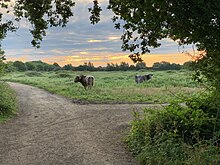
Back إعادة الطبيعة البرية (علم الحماية الحيوية) Arabic Resilvestració Catalan Dad-ddofi Welsh Rewilding Danish Rewilding German Resilvestración Spanish Berbasatze (kontserbazio biologia) Basque بازگردانی طبیعت وحشی Persian Villiinnytys Finnish Réensauvagement French

Rewilding is a form of ecological restoration aimed at increasing biodiversity and restoring natural processes. It differs from other forms of ecological restoration in that rewilding aspires to reduce human influence on ecosystems.[1] It is also distinct from other forms of restoration in that, while it places emphasis on recovering geographically specific sets of ecological interactions and functions that would have maintained ecosystems prior to human influence, rewilding is open to novel or emerging ecosystems which encompass new species and new interactions.[2][3]
A key feature of rewilding is its focus on replacing human interventions with natural processes. Rewilding enables the return of intact, large mammal assemblages, to promote the restoration of trophic networks.[4] This mechanism of rewilding is a process of restoring natural processes by introducing or re-introducing large mammals to promote resilient, self-regulating, and self-sustaining ecosystems.[5][6] Large mammals can influence ecosystems by altering biogeochemical pathways as they contribute to unique ecological roles, they are landscape engineers that aid in shaping the structure and composition of natural habitats.[7][8] Rewilding projects are often part of programs for habitat restoration and conservation biology, and should be based on sound socio-ecological theory and evidence.[9]
While rewilding initiatives can be controversial, the United Nations has listed rewilding as one of several methods needed to achieve massive scale restoration of natural ecosystems, which they say must be accomplished by 2030[10] as part of the 30x30 campaign.[11]
- ^ Sandom, Chris; Donlan, C. Josh; Svenning, Jens-Christian; Hansen, Dennis (15 April 2013), Macdonald, David W.; Willis, Katherine J. (eds.), "Rewilding", Key Topics in Conservation Biology 2 (1 ed.), Wiley, pp. 430–451, doi:10.1002/9781118520178.ch23, ISBN 978-0-470-65876-5, retrieved 29 March 2024
- ^ Carver, Steve; et al. (2021). "Guiding principles for rewilding". Conservation Biology. 35 (6): 1882–1893. Bibcode:2021ConBi..35.1882C. doi:10.1111/cobi.13730. PMID 33728690. S2CID 232263088.
- ^ Svenning, Jens-Christian (December 2020). "Rewilding should be central to global restoration efforts". One Earth. 3 (6): 657–660. Bibcode:2020OEart...3..657S. doi:10.1016/j.oneear.2020.11.014. ISSN 2590-3322.
- ^ Cromsigt, Joris P. G. M.; te Beest, Mariska; Kerley, Graham I. H.; Landman, Marietjie; le Roux, Elizabeth; Smith, Felisa A. (5 December 2018). "Trophic rewilding as a climate change mitigation strategy?". Philosophical Transactions of the Royal Society B: Biological Sciences. 373 (1761): 20170440. doi:10.1098/rstb.2017.0440. ISSN 0962-8436. PMC 6231077. PMID 30348867.
- ^ Cromsigt, Joris P. G. M.; te Beest, Mariska; Kerley, Graham I. H.; Landman, Marietjie; le Roux, Elizabeth; Smith, Felisa A. (5 December 2018). "Trophic rewilding as a climate change mitigation strategy?". Philosophical Transactions of the Royal Society B: Biological Sciences. 373 (1761): 20170440. doi:10.1098/rstb.2017.0440. ISSN 0962-8436. PMC 6231077. PMID 30348867.
- ^ Bakker, Elisabeth S.; Svenning, Jens-Christian (5 December 2018). "Trophic rewilding: impact on ecosystems under global change". Philosophical Transactions of the Royal Society B: Biological Sciences. 373 (1761): 20170432. doi:10.1098/rstb.2017.0432. ISSN 0962-8436. PMC 6231072. PMID 30348876.
- ^ Lundgren, Erick J.; Ramp, Daniel; Ripple, William J.; Wallach, Arian D. (June 2018). "Introduced megafauna are rewilding the Anthropocene". Ecography. 41 (6): 857–866. Bibcode:2018Ecogr..41..857L. doi:10.1111/ecog.03430. ISSN 0906-7590.
- ^ Athumani, Paulo C.; Munishi, Linus K.; Ngondya, Issakwisa B. (January 2023). "Reconstructing Historical Distribution of Large Mammals and their Habitat to Inform Rewilding and Restoration in Central Tanzania". Tropical Conservation Science. 16: 194008292311668. doi:10.1177/19400829231166832. ISSN 1940-0829.
- ^ Svenning, Jens-Christian (December 2020). "Rewilding should be central to global restoration efforts". One Earth. 3 (6): 657–660. Bibcode:2020OEart...3..657S. doi:10.1016/j.oneear.2020.11.014.
- ^ Greenfield, Patrick (3 June 2021). "World must rewild on massive scale to heal nature and climate, says UN". The Guardian. London. Archived from the original on 5 June 2021. Retrieved 1 June 2022.
- ^ Jepson, Paul (18 May 2022). "The creative way to pay for wildlife recovery". Knowable Magazine. doi:10.1146/knowable-051822-1. Archived from the original on 31 May 2022. Retrieved 31 May 2022.